While anyone can pay content creators for sponsored posts, only a few manage to leverage them as their main growth channel. Still, collaborating with content creators is one of the most effective marketing channels — and it's set to play an even bigger role moving forward.
Over the past few years, the creator landscape has evolved significantly. Today, content creators include not only traditional influencers with large audiences but also micro/nano influencers, clippers, VTubers, faceless creators… Success in collaborations now goes beyond simply choosing the right creator. It has become a numbers game that requires smart briefs, streamlined funnels, and incentive structures that drive real results.
Over the past few months, I've tested dozens of tactics to identify high-potential content creators, reach out to them at scale, and convert some into long-term ambassadors. From reverse-engineering competitors' creator lists to automating outreach, I've used hacks and systems that helped grow my latest mobile app from $0 to $103K MRR in just 86 days.
In this edition, I’ll share the top tactics we use at THE QUEST so you can effectively leverage creators for your own growth.
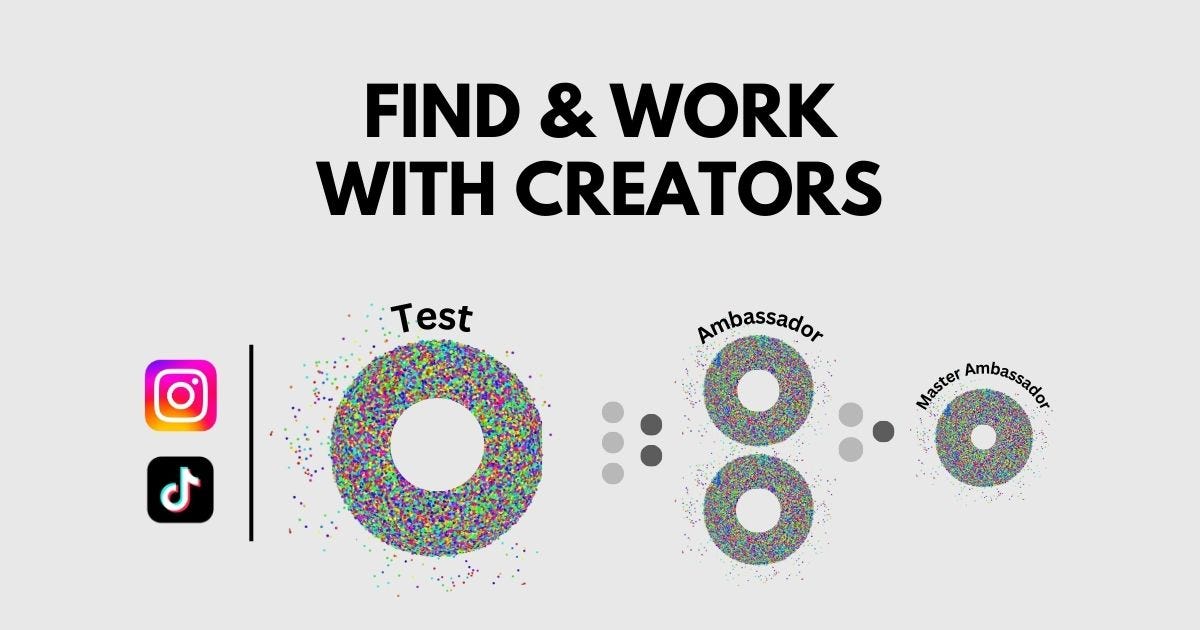
Finding the right content creators
The first step is to build a targeted list of creators you want to reach. I strongly recommend refining this list before contacting anyone or making deals. Many people mix research and outreach, which leads to sloppy execution and lackluster results.
When searching for content creators, focus on individuals who can produce and distribute content that actually benefits your company. Not all content creators are traditional influencers with large followings. Some are micro/nano-influencers, others manage multiple slideshow accounts, and some run clipping farms. A few of my top-performing creators started with brand-new accounts and zero audience — but delivered outstanding results because they're simply great at creating content.
When building your creator list, define clear search criteria and be selective with each profile. Alongside your company-specific filters, here are key traits I recommend prioritizing:
Work with creators physically based in your target country.
Find creators who embody their market (language, look, attitude, vibe).
Prioritize nano or micro-creators with consistent engagement.
Look for coachable, responsive creators open to feedback and iteration.
Seek creators who naturally create conversion-focused content
There are several ways to build your creator list, and the best approach often depends on your company's sector. Here's a breakdown of the proven tactics I've used successfully:
1/ Find experienced creators
One of the best ways to find great content creators for your company is to seek out those who partner with companies in the same business category as yours, targeting the same audience but with distinct offerings. For example, if you're developing a nutrition mobile app for Gen Z, focus on creators who work with other mobile app companies targeting Gen Z (rather than those who collaborate with e-com brands for seniors…).
Many top creators collaborate with multiple apps, generating millions of views for each. One, for example, drove 185M views across three Gen Z–focused apps: 89M for Glam AI, 40M for Yope, and 55M for Couple Joy. A creator who understands your company type (e.g., a mobile app) and has already attracted your target audience through another project is much more likely to help your app go viral. Here are the different methods to find experienced content creators:
Method 1: Analyze competitor followers
Identify competitor brand social accounts (e.g., @yopeapp).
Review the accounts they follow to find relevant creators.
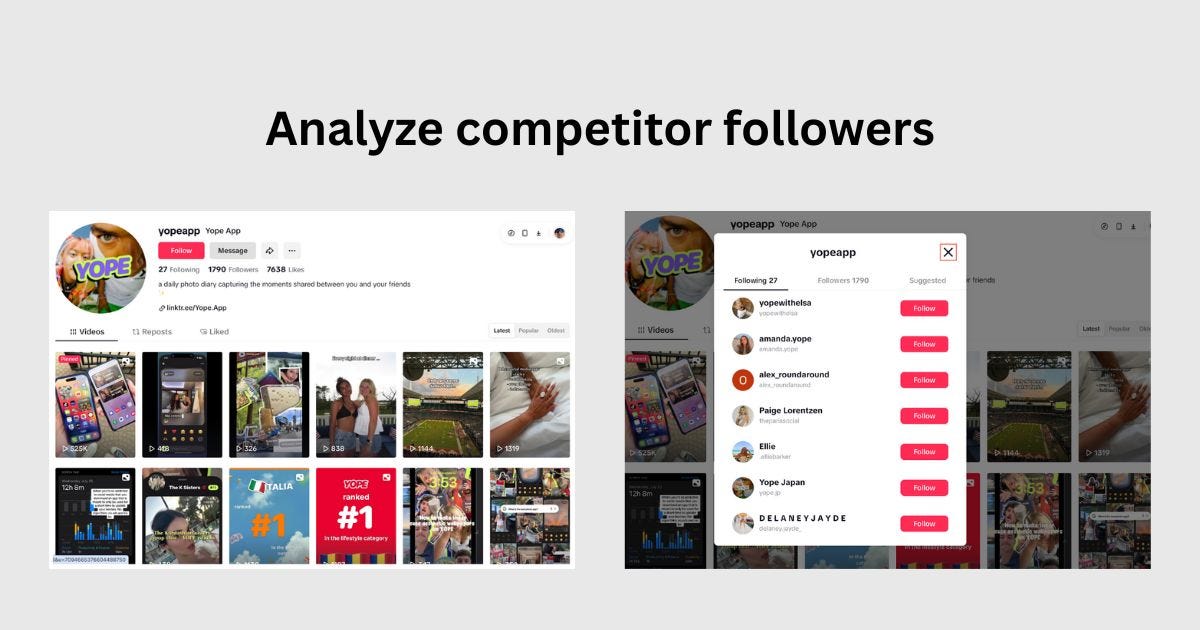
Method 2: Explore competitor hashtags
Check competitor brand hashtags on socials (e.g., #yopeapp).
Collect profiles that use these hashtags.
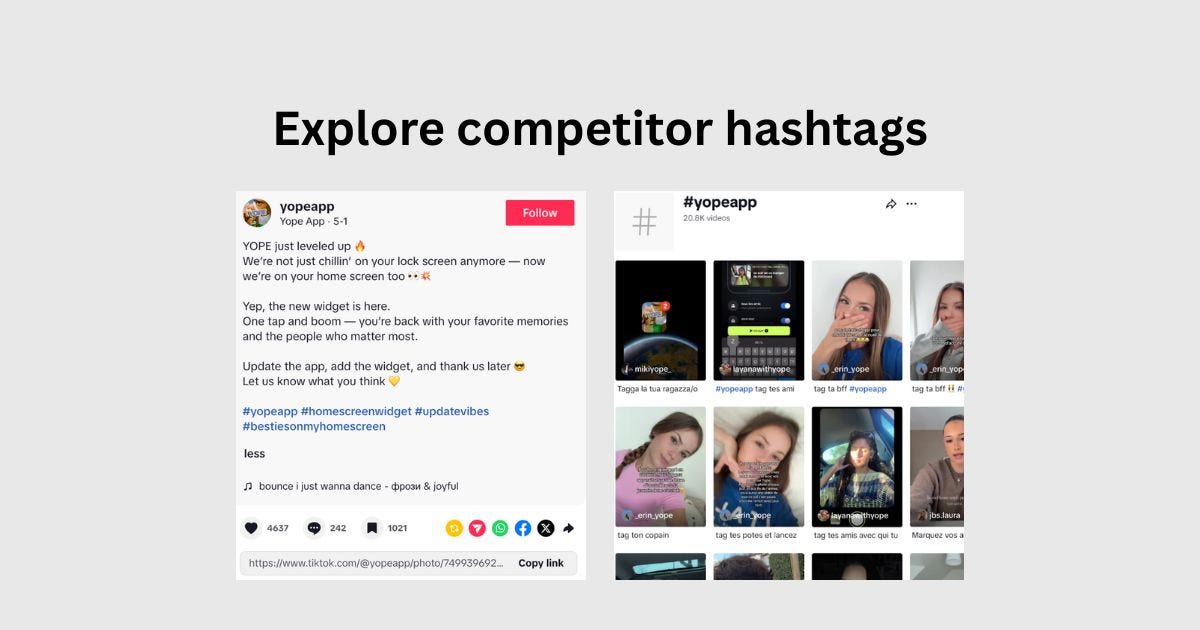
Method 3: Search niche keywords
Search for keywords related to your niche in TikTok's search bar using advanced mobile filters (e.g., #photowidget).
Review accounts promoting relevant content.
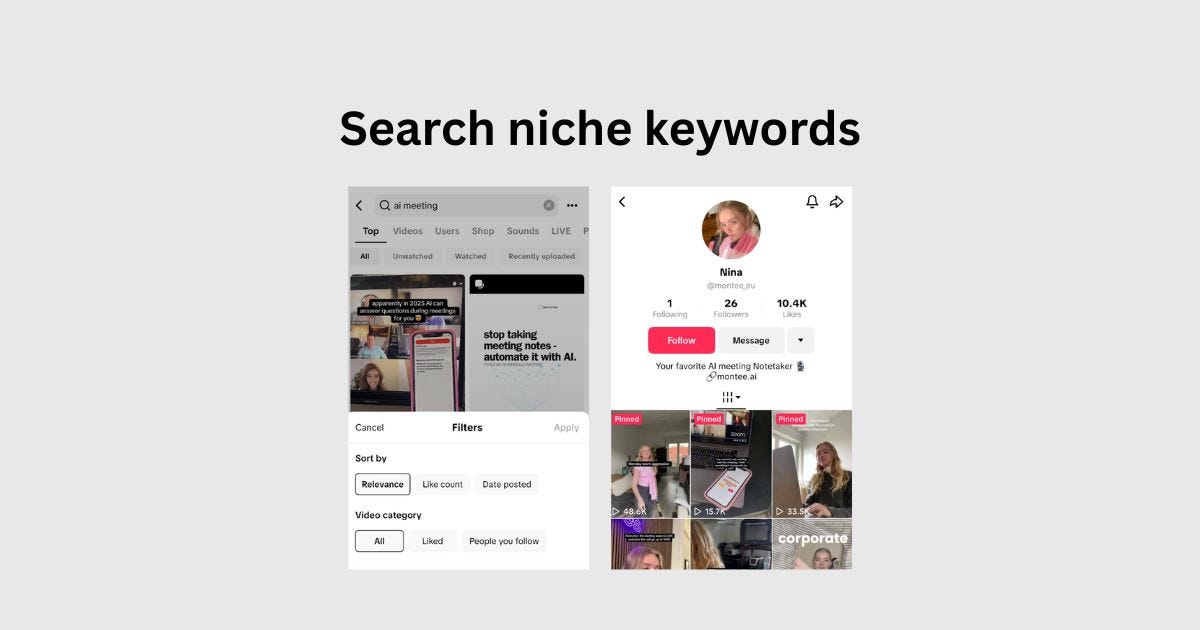
You can also access public lists of creators who have worked with leading companies (Yope, Cluely, Duolingo…) through resources from various tracking tools. These curated lists help you identify creators with a proven track record in your niche, increasing your chances of successful collaborations.
2/ Find creators from socials feeds
A powerful way to discover creators is by exploring social feeds, particularly TikTok's For You Page. When used effectively, this feed helps you identify top-tier content creators. Here's how to effectively warm up your TikTok account to ensure the For You Page recommends the most relevant creator profiles:
Configure a dedicated phone for your target market:
Follow my tutorial to configure your device for your target marketCreate and warm up a dedicated TikTok account (for at least five days):
Mimic your target persona's behavior on TikTok: adopt their language, follow their accounts, and engage with content they're likely to enjoy.
Within a week, you'll see relevant content and creators that match your audience, giving you opportunities to connect.
3/ Find creators from creator databases
You can find creators through traditional creator databases such as Favikon, Modash, and Heepsy, but you can also use AI-powered databases like TopYappers.
I like this tool because it helps me find creators based on the topics they cover. For example, if you want to build an AI slide generator, you can search for PowerPoint and see creators who talk about PowerPoint, then reach out and collaborate with them.
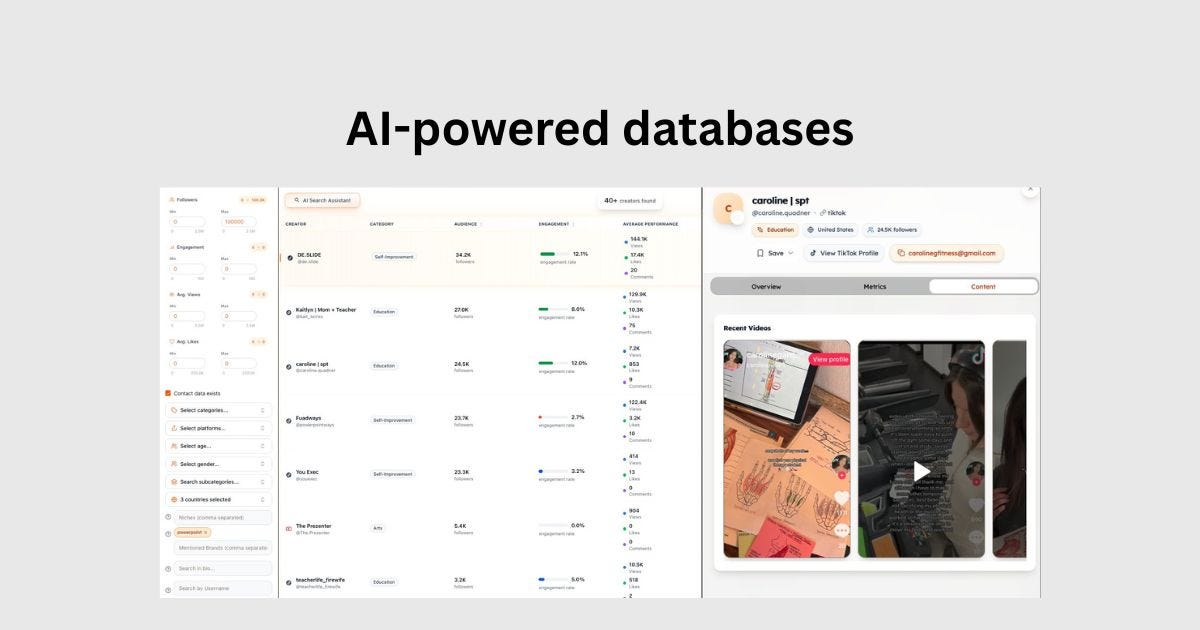
When choosing a creator database, pay attention to two key factors:
Update frequency:
Make sure the database refreshes regularly so the data stays accurate.Filtering granularity:
Use detailed filters to pinpoint creators who align with your niche.
You can find all the creator databases in my article :
100 Tools to Create Viral Mobile Apps.
4/ Find creators from creator marketplaces
Creator marketplaces are another way to find talented content creators. Honestly, I haven't had much success with them myself, but friends have found high-performing creators on these marketplaces, so they're worth exploring based on your company's niche and audience. These marketplaces simplify collaboration by connecting you with creators ready to work.
You can find all creator marketplaces in my article:
100 Tools to Create Viral Mobile Apps.
5/ Find creators from student marketplaces
This approach has worked really well for me. It may not fit every industry, but if you're looking for young content creators, student job marketplaces are one of the best places to start.
In the U.S., marketplaces like Home From College, Sideshift, Handshake, and CampusReel connect you with students eager to work on real projects. They bring fresh ideas, a pulse on what's trending, and serious drive to build their portfolios. Some may lack the polish of seasoned pros, so it's key to filter by skills, commitment, and vibe. These marketplaces make that easy with tools to sort by availability, interests, and expertise.
To make collaborations work, be clear about your goals, give regular feedback, and keep communication open. For even more talent, you can check out niche Discord servers and Reddit threads where students share portfolios and look for gigs:
6/ Find creators from LinkedIn & X posts
I've been blown away by the creators I've found through this method. The secret is to drop a killer lead-magnet post that pulls in top talent. You can go direct — talking about your ambassador program — or keep it subtle with a post that indirectly attracts high-quality content creators. Nail that, and you'll be shocked at how quickly the right people show up.
For example, I ran a few lead-magnet posts to launch an app distribution bootcamp (Viralsquad bootcamp). From the applicants, I handpicked four creators with standout content skills in the countries I wanted to target with my new app. After a bit of training, they became my top content creators.
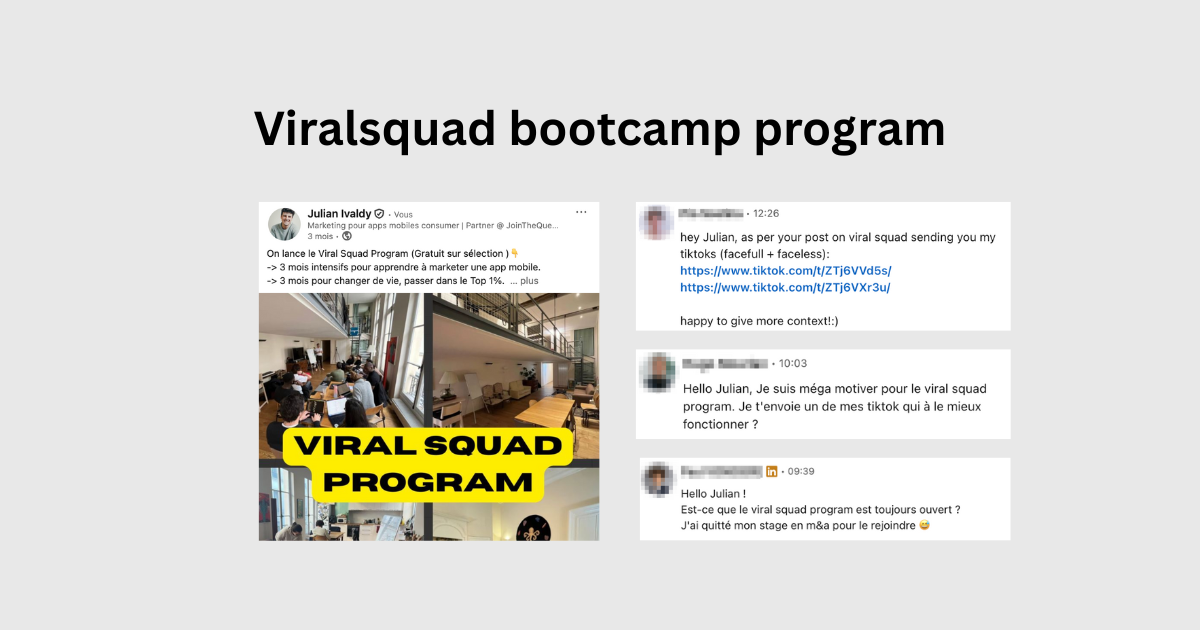
The trick is to ask applicants to like and comment to apply, and encourage people to tag or refer creators they know. This will boost your post's reach like crazy.
7/ Find creators from referrals program
You can launch a creator referral program with a reward that's clear and appealing. Start by sharing it within your own circle, you'd be surprised how many creators are just one connection away. A friend of a friend might already be pulling millions of views on Instagram, or maybe a colleague's friend is quietly running a thriving TikTok account.
Beyond your network, you can also take it public. The most effective approach is to put it right in front of your customers: promote it on your branded socials, talk about it openly in build-in-public posts, or even integrate a direct CTA inside your product (for example, in your app).
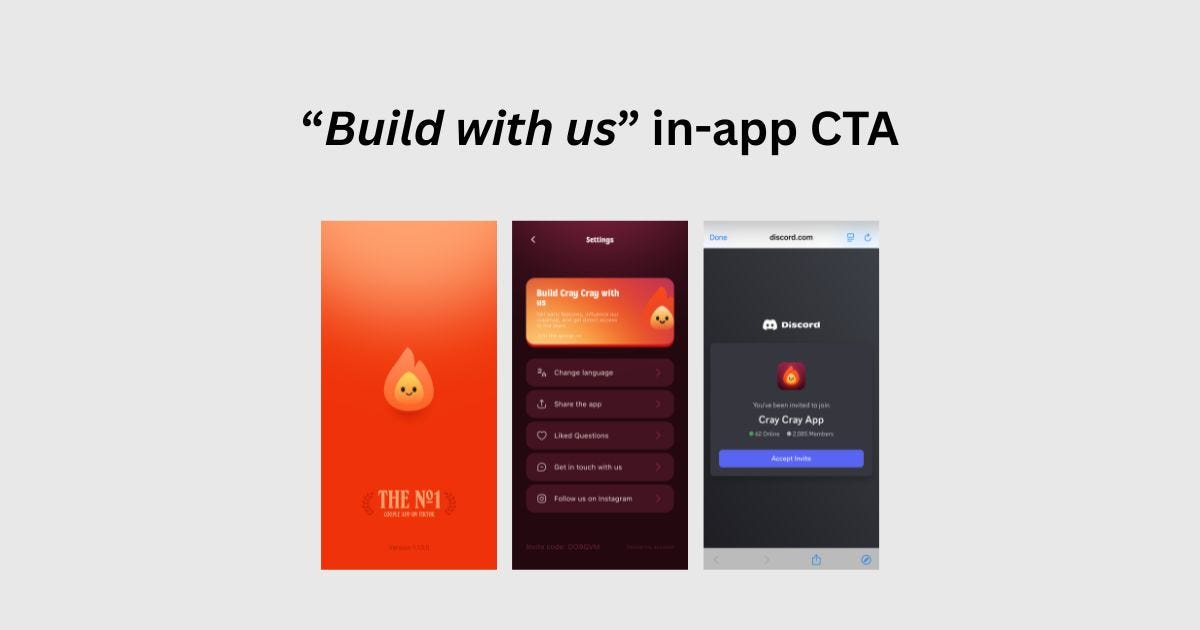
Reaching out to creators
Once you've got your creator list ready, it's time to kick off outreach. Getting replies is a numbers game. You have two main approaches: go direct and share your offer in the first message, or play it subtle to spark a conversation. I lean toward the second option since it usually converts better. That said, in the U.S., I've noticed my conversion rate drops sharply after the first interaction.
If you spot a promising creator on a student marketplace, you'll likely want to hit them up right there to start building a connection — But I always recommend following up on their main social channel (Twitter, Instagram, email, etc.). For example, I've seen much better results reaching out to creators I found in a creator database through Instagram rather than using the database's built-in email feature.
1/ Contact creators by DMs (Manual)
The most effective way to get replies is to DM each creator directly on their main socials with a message that feels genuinely personal. This is where you'll see the highest response rates. Start by engaging with their content, then follow up with a personalized message (while A/B testing it).
Recommended message structure:
"Hey [CREATOR NAME],
I'm [NAME] from @ [COMPANY]!If you haven't heard of us, we're [COMPANY DESCRIPTION] — currently #1 on the App Store in 8+ countries with over 1M users.
I came across your account and really enjoyed your recent videos about [PERSONALIZATION 1]. They reminded me of [PERSONALIZATION 2].
We're launching @ [COMPANY] in [CREATOR COUNTRY] and would love to do a paid collaboration with you (upfront fixed payment + % bonus).
Let me know if you'd like more details!"
If you want to keep a high level of personalization, the only way to scale it is to delegate at scale. That means surrounding yourself with VAs, interns, or ambitious assistants who can help you reach out to as many people as possible every day.
2/ Contact creators by DMs (Automated x Chrome extensions)
You can use Chrome extensions to automate DMs and scale your outreach. These tools let you send bulk semi-personalized messages on socials like Instagram, TikTok, Twitter, LinkedIn…
I personally use Slide, a tool built specifically for finding and reaching out to TikTok and Instagram creators. Just be careful with your DM frequency to avoid getting banned. I stick to around 50 DMs per day and run them through active, dedicated accounts to avoid bans.
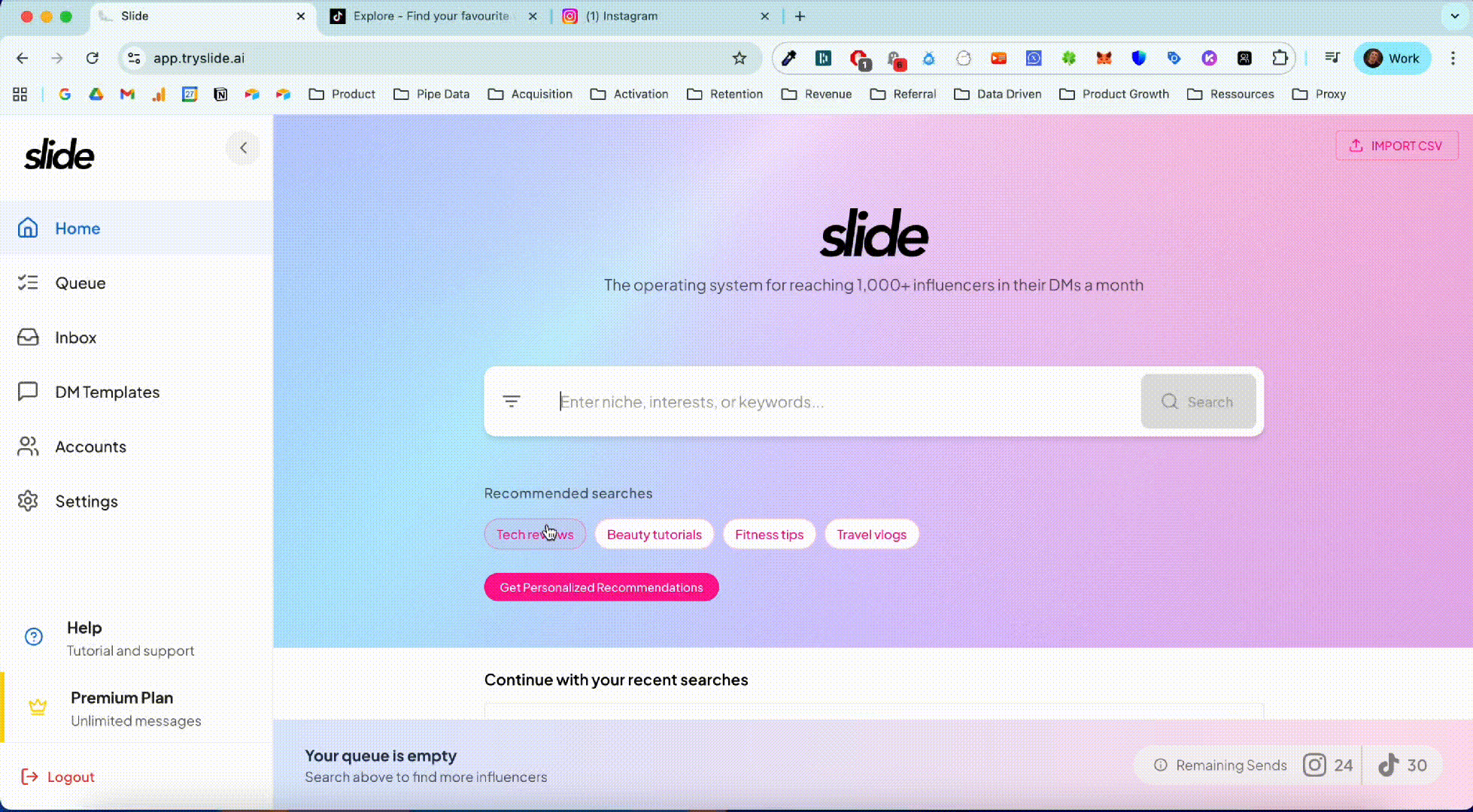
You can find all creators' outreach tools in my article:
100 Tools to Create Viral Mobile Apps.
3/ Contact creators by DMs (Automated with OTG chip)
To scale your DM outreach without risking bans, you can automate DMs directly on your device (using an OTG chip). Instead of relying on web tools that socials can easily detect, you can build your own farm and run a dedicated script to send DMs automatically. It works just like the warm-up farm I've been sharing on X.
This way, you can reach hundreds of creators every day without spending hours copy-pasting or burning your main accounts. The trick is to manage frequency, warm up accounts properly, and distribute the load so everything looks organic.
If you want to build your farm, check out my article Create an Automated TikTok & Instagram Farm. I just updated my vibe-coded OS frontend with a new DM feature Mobile Consumer Kit.
4/ Contact creators by emails (with IOS shortcut)
You can contact creators via email without ever leaving TikTok using a simple iOS shortcut I built. This shortcut lets you collect & save info from any profile you find interesting, grab their email, and send a personalized email — all without leaving the app. With a simple Apple shortcut and a few scenarios, you can streamline the entire process.
The shortcut will simply collect the bio information of creators and send it through a webhook. The webhook will trigger a Make scenario, which extracts the email from the bio, analyzes the profile with AI, generates a personalized outreach email, logs everything in Google Sheets, and finally sends the tailored email automatically via SendGrid.
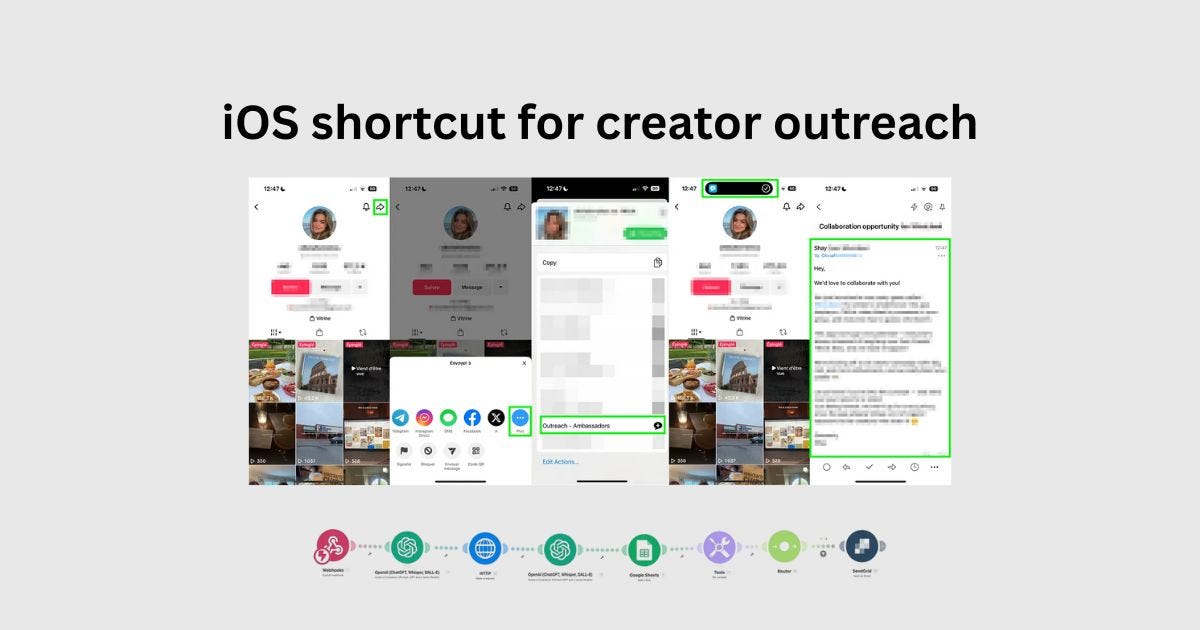
Here is the shortcut link: https://www.icloud.com/shortcuts/59b9b20d33af43309d4bf5eabcee6dc4
5/ Contact creators by emails (with cold email)
Cold email is a great way to land collaborations with creators. The key is balancing deliverability (your emails need to hit the inbox, not spam) with authentic personalization (creators can spot copy-paste from a mile away).
For bulk outreach, use dedicated cold email tools that let you:
Warm up your sending domain so you don't get flagged as spam
Personalize at scale with variables (name, niche, recent content, etc.)
Automate multi-step sequences with delays and follow-ups
I personally use Emelia, but you can also use Instantly, Smartlead, Apollo…
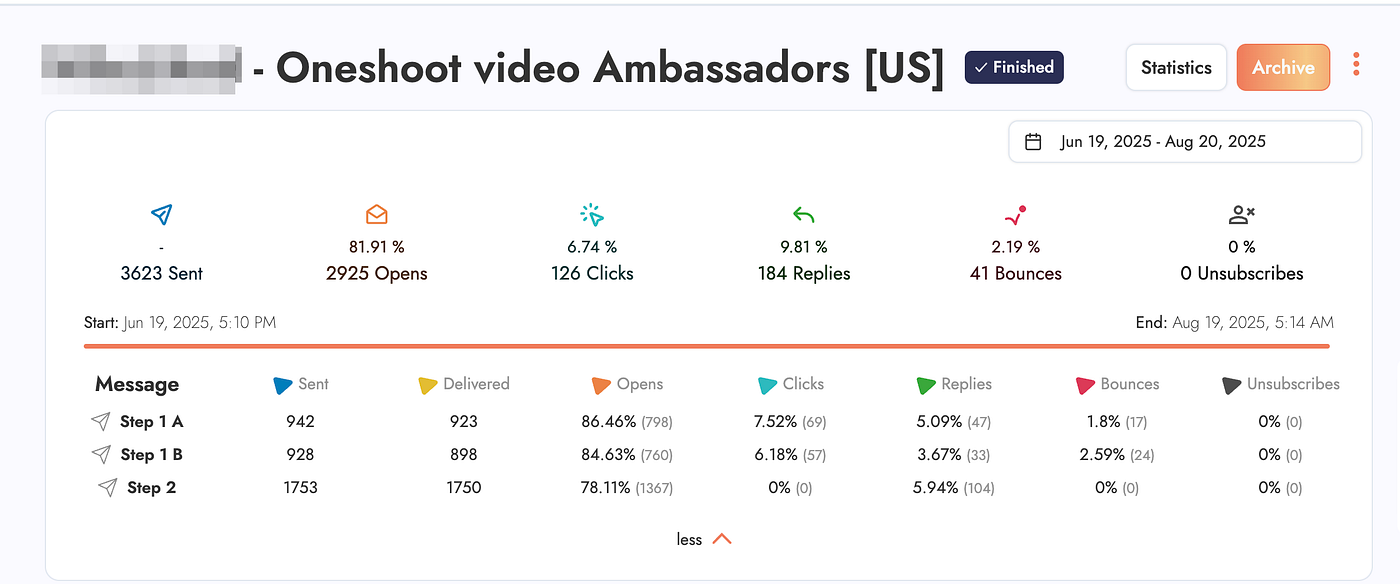
You can find all cold email tools in my article:
100 Tools to Create Viral Mobile Apps.
Recommended cold email structure:
Intro + why them → Mention their niche, content style, or something specific they did
Value proposition + proof/examples → Explain what you bring, backed with clear social proof or case studies
Call-to-action + scarcity/final follow-up → Give them a simple next step (reply, call, etc.) and add urgency (limited spots, campaign kicking off soon, etc.)
To boost your email outreach, keep emails short, sticking to three to five sentences, since long walls of text rarely get read. Use simple, catchy subject lines like "Quick collab idea for [FirstName]" to grab attention. Include one or two highly personalized lines in each email, even when sending at scale, to make your message feel tailored. Always run A/B tests on subject lines and opening lines to figure out what clicks best with your audience.
I've seen much better results cold emailing people I found through my iOS Shortcut compared to emails from public databases. The iOS Shortcut is a double win: some people convert right away from the shortcut's personalized email, while others reply when I re-contact them later with a specific campaign offer (like a Christmas campaign) via cold email.
Collaborating with creators effectively
Once creators reply, your goal is to guide them through a clear and structured funnel that maximizes both performance and long-term collaboration. This means turning those initial conversations into a well-defined collaboration where expectations, goals, and deliverables are fully aligned.
To achieve this, you need to design your step-by-step creator funnel, and make sure every creator will follow it. A clear creator funnel turns interested creators into high-performing partners. Most failures don't come from 'bad creators'. They come from unclear expectations, vague instructions, and out-of-sync asks. You can't expect someone who's never heard of you to hit a million views on their first try. But you can guide them through a clear process so they learn what works, why it works, and how to repeat it — until they finally do.
1/ Test phase
When you bring in new creators, don't base your opinion on their very first video. That's the trap most companies fall into. Early on, the goal isn't to "go viral" — it's to see if the creator has the right foundations to succeed with you long term.
Don't chase instant results, use the test phase to see if they're reliable and genuinely understand how to win on social.
1. Reliability as a person
Before judging post performance, make sure the creator is trustworthy.
Notice how they behave:
Do they answer fast and clearly when you reach out?
Do they treat the project like work, not just a side hobby?
Do they actually deliver when they say they will?
If the human side isn't solid, the partnership will feel messy no matter how good their content looks. The next thing to check is whether they truly understand the codes of socials.
2. Native feel for socials
It comes down to their instinct for how content performs on platforms like TikTok and Instagram.
Signs to check:
They catch trends early and know how to use them.
Their music picks feel natural and aligned with what's hot.
They give you feedback that helps improve results, not just surface comments.
When you combine personal reliability with socials instinct, you'll know you've found a creator worth testing. At that point, make onboarding simple: send them a template message with your app details, sample videos, and a suggested script & flow they can riff on.
Recommended template structure:
"Hi [CREATOR NAME],
Thanks for your reply and your interest!To start the collaboration:
📲 Create a simple video and post it on your personal account.
💰 You'll be paid $X/video upfront + a $Y bonus if it reaches Z+ views.If you're in:
1/ Send us your preferred payment method so we can issue the payment.
2/ Download [APP NAME] and use the code [CODE] to unlock premium.
3/ Create one short video in the style of the examples sent below.Once I receive your payment details, I'll share the video script & flow."
The video example you send should follow a proven, high-performing format — something that has already delivered strong results for you or your competitors. For the script, keep it simple: a short text they can easily rephrase in their own tone. What matters most is the video flow, the step-by-step structure they should follow.
Most winning videos follow this basic flow:
Hook → Problem → Solution → Call to Action
A winning video often follows a simple structure that mirrors a natural storytelling arc. It starts with a hook: the creator appears on camera in a casual, relatable setting, immediately grabbing attention and making the viewer feel like they're watching a friend, not an ad. Then comes the problem: a short, familiar moment that highlights the old, ineffective way of doing something, something the viewer has likely experienced themselves. Next is the solution: your product is shown in action, often with a specific screen or feature that directly solves the problem. Finally, the video ends with a clear call to action, typically showing the App Store or Play Store download screen, prompting the viewer to try the product for themselves.
2/ Ambassador phase
Once a creator passes the test phase, you can propose that they become an ambassador. An ambassador will have a long-term partnership with your company. They will have a dedicated account, and act as a representative of your company. To onboard a creator into your ambassador program, you need to send them a template message along with an ambassador guide presenting your program
Recommended template structure:
"Hi [CREATOR NAME],
Thanks again for your test video — we'd love to move forward with you!To get started as an Ambassador:
🆕 Create a dedicated account using this email: [EMAIL PROVIDED]
📲 Post 20 videos/month in your own style (we'll send fresh examples).
💰 Deal: $X/month + a $Y CPM bonus based on performance.All program details can be found here: [AMBASSADOR GUIDE]
Let me know if you're ready to join — excited to scale this together!"
Regarding the ambassador guide, you can create a simple Google Doc or Notion page and go further by including more details about your app, the dos and don'ts, additional inspiration content, best practices from other ambassadors, and real-time top-performing posts from all creators.
If you want access to top ambassador and affiliate program guides, just DM me. I've curated some of the best, including the Jenni AI ambassador playbook.
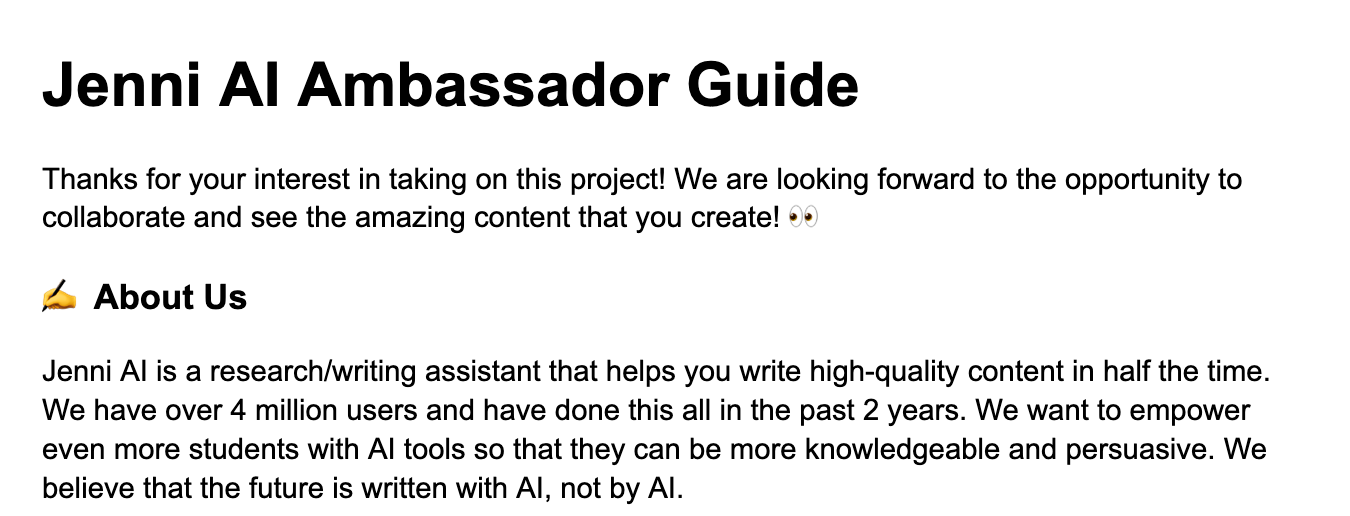
When a creator becomes an ambassador, add them to a dedicated group of ambassadors — ideally organized by country or region. This creates a sense of community, makes communication easier, and allows them to learn from each other. In-country groups also help with local trends, cultural context, and language alignment.
I recommend using one of these three platforms to manage your ambassador groups: WhatsApp, iMessage, or Instagram. Personally, I prefer Instagram — it makes it easy to group creators by type, tag them for sorting, and even involve them in other marketing efforts (more on that later).
3/ Master ambassador phase
Once you've identified top-performing ambassadors, you can take things a step further by turning them into Master Ambassadors. After 2–3 months of consistent results and a solid working relationship, I usually invite my top ambassadors to take on this expanded role.
Master Ambassadors continue creating content through their regular ambassador account, but they also take responsibility for recruiting and managing new ambassadors in their market. They become the admin of their country-specific ambassador group and are accountable for the performance of the ambassadors they bring in.
In terms of compensation, Master Ambassadors keep their standard deal but earn additional incentives based on their network's performance. I typically offer them 25% of the fixed payment given to each ambassador they recruit, plus a views-based bonus from the creators they manage.
To onboard a new Master Ambassador, I usually propose a quick call to introduce the idea. If they're interested, I bring them in quickly and schedule a weekly sync to stay connected. It hasn't happened yet, but I could absolutely see myself hiring one or two of my top Master Ambassadors full-time — they're that valuable.
4/ Deal structures:
What you pay will depend on your industry, business model (e.g., mobile app, e-commerce, SaaS), target audience, and current brand awareness.
To give you an idea, here's what I usually offer:
$30–$50 for a test post
$400–$600/month for ambassadors
$1,000–$1,200/month for master ambassadors
For payments, I usually use bank transfer and PayPal, depending on what's most convenient for the creator. Most of them don't have a registered business, so for accounting purposes, I provide a payment acknowledgment confirming the funds were sent to an individual who isn't subject to VAT. From there, it's up to them to report the income according to their local tax laws.
Leveraging your creator army
A creator army is a powerful marketing asset. Beyond content, they drive growth across multiple channels. Here's how to maximize their impact:
1/ Winning Organic Scale
Share your top-performing organic content with creators and have them produce their own versions. On average, this simple replication multiplies views and conversions by 10–20x.
2/ Winning Ad Twist
Ask creators to re-do your top-performing ads, giving you fresh twists and remixes of proven winners that you can re-upload into your ads manager to keep scaling and optimize CPI.
3/ Reviews Challenge
Ask creators to collect product reviews from their audience by creating build-in-public style videos. The content should spark curiosity and encourage viewers to leave reviews, while remaining indirect and compliant with platform rules.
I'll share a full breakdown on turning creators into a multi-channel growth engine in an upcoming post. Feel free to subscribe to stay updated.
👋 Awesome you made it to the end — hope this helps!
If you wanna chat about mobile apps, feel free to DM me on X.
And if you're building a consumer mobile app, join the Discord!